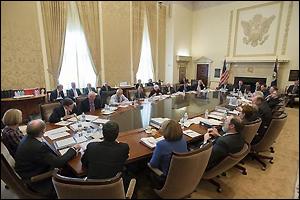By Pam Martens and Russ Martens: February 19, 2015
Before we analyze in plain English the minutes released yesterday by the Federal Open Market Committee (FOMC) of the Federal Reserve Board relating to its discussions at its last meeting on January 27-28, 2015, you need a few salient background facts.
The FOMC first set its Federal Funds rate at 0 to ¼ percent (the zero bound range) on December 16, 2008. That’s more than six years ago. If the U.S. was in the recovery stage following a deep recession, we would have exited the zero bound range a long, long time ago. Clearly, we have yet to accurately define the economic twilight zone we’ve entered.
Secondly, the Fed’s happy talk about the solid growth in the U.S. economy that may warrant a rate hike sometime this year just doesn’t comport with the reality of the situation. On February 10, Steve Ricchiuto, Chief U.S. Economist at Mizuho Securities USA, who has a Masters Degree in Economics from Columbia University, appeared on CNBC to succinctly explain that reality. Ricchiuto had this to say:
“…I keep hearing over and over again in the financial press about this acceleration in economic growth. That isn’t happening. Last month we had a horrible retail sales number. We had a horrible durable goods number. We’re likely to have a very disappointing retail sales number coming forward. This month we’ve had a strong payroll number – we say everything’s great. It’s not great. It’s running where it’s been. It’s been the same thing for the last five years. There’s no improvement in the economy.”
The unprecedented nature of this period has been captured by David Papell and Ruxandra Prodan, Professor of Economics and Clinical Assistant Professor of Economics, respectively, at the University of Houston. Writing at Econbrowser, the pair had this to say:
“While the Great Recession of December 2007 to June 2009 ended over five years ago, the recovery has been characterized by very slow growth. The Congressional Budget Office has recently released projections of real (inflation adjusted) GDP growth through 2025. If these projections turn out to be correct, real GDP for the U.S. will never return to its pre-Great Recession growth path. This projected decrease in potential GDP is unprecedented, as almost all postwar U.S. recessions, postwar European recessions, slumps associated with European financial crises, and even the Great Depression of the 1930s were characterized by an eventual return to potential GDP.”
The authors do not offer answers as to why GDP growth cannot be restored to pre-financial- crisis levels but we, as many others, believe it is a result of the unprecedented wealth and income inequality in the U.S. Until Congress takes decisive action to rebalance the gap, we’ll remain in this economic twilight zone.
Now for the Fed minutes released yesterday. Despite the continued chatter in the financial press of just when the Fed’s rate hike is coming, the FOMC had to admit to quite a number of hard to ignore decelerations in economic activity. Here’s a few relevant quotes on that topic: (Italics are ours.)
“Real private expenditures for business equipment and intellectual property appeared to decelerate in the fourth quarter. Nominal orders and shipments of nondefense capital goods, excluding aircraft, declined in November and December.”
“Real federal government purchases appeared likely to have decreased sharply in the fourth quarter, reversing much of the surprisingly strong increase in the third quarter.”
“Over the 3 months ending in December, the total CPI [Consumer Price Index] decreased at an annual rate of 2-1/2 percent, reflecting recent declines in consumer energy prices…”
“Inflation in the advanced foreign economies declined sharply at the end of last year, amid rapidly falling energy prices…”
“The price of mortgage credit for qualified borrowers declined again over the intermeeting period, with interest rates on 30-year fixed-rate mortgages reaching levels close to their all-time lows.”
Nothing in the above statements is consistent with a solidly expanding economy at risk of overheating – in fact it is completely inconsistent with that scenario. And yet the Fed sums up its thinking with this:
“In their discussion of monetary policy for the period ahead, members judged that information received since the FOMC met in December indicated that economic activity had been expanding at a solid pace…”
There’s more evidence that the Fed believes the American public requires a Goldilocks’ spin on the reality of the situation. The excessively wordy Fed minutes used the word “deflation” just once and that was in the context that perhaps “pent-up wage deflation might have weighed on wage gains for a time” and “could be expected to pick up in coming periods…”
Not once does the Fed use the word “deflation” to describe the stunning deflation hitting ten of our trading partners in November with another seven showing inflation running below one-half of one percent.
The Fed soft-pedaled that reality as follows:
“Several central banks announced monetary policy actions during the period. The ECB announced that it would expand its asset purchase program to include the purchase of sovereign bonds; the euro depreciated significantly against the dollar both in anticipation of and following this announcement. The Swiss National Bank (SNB) ended its policy of defending the exchange rate floor of 1.20 Swiss francs per euro, resulting in a significant appreciation of the franc. At the same time, the SNB reduced policy rates, moving the rate it pays on deposits and its target range for Swiss franc LIBOR, or London interbank offered rate, further into negative territory. The Bank of Canada, National Bank of Denmark, Reserve Bank of India, and Central Bank of Turkey also cut policy rates in January to support their economies and, in some cases, to foster higher inflation…”
We have only three words of advice for investors against this backdrop: tread with caution.


